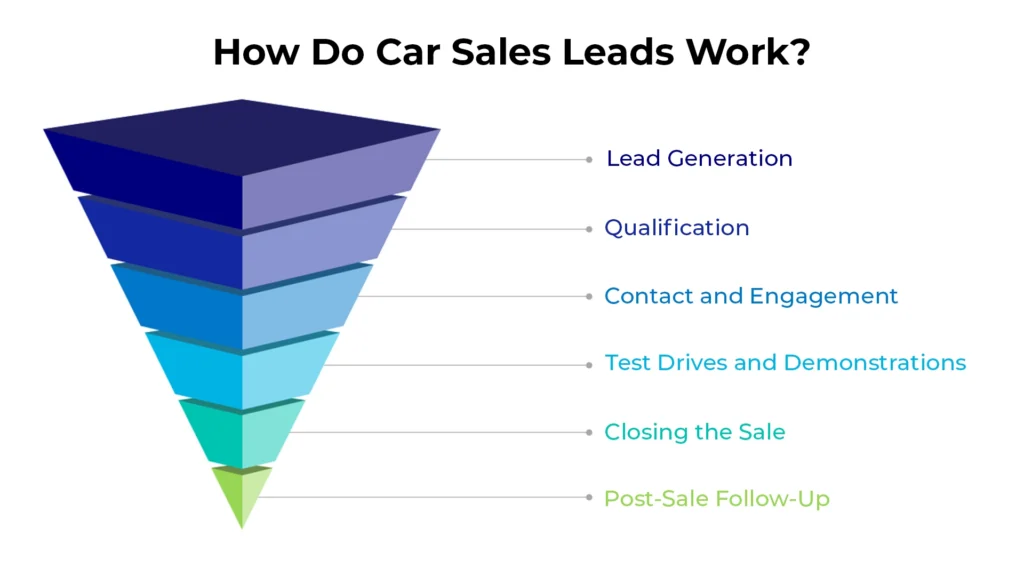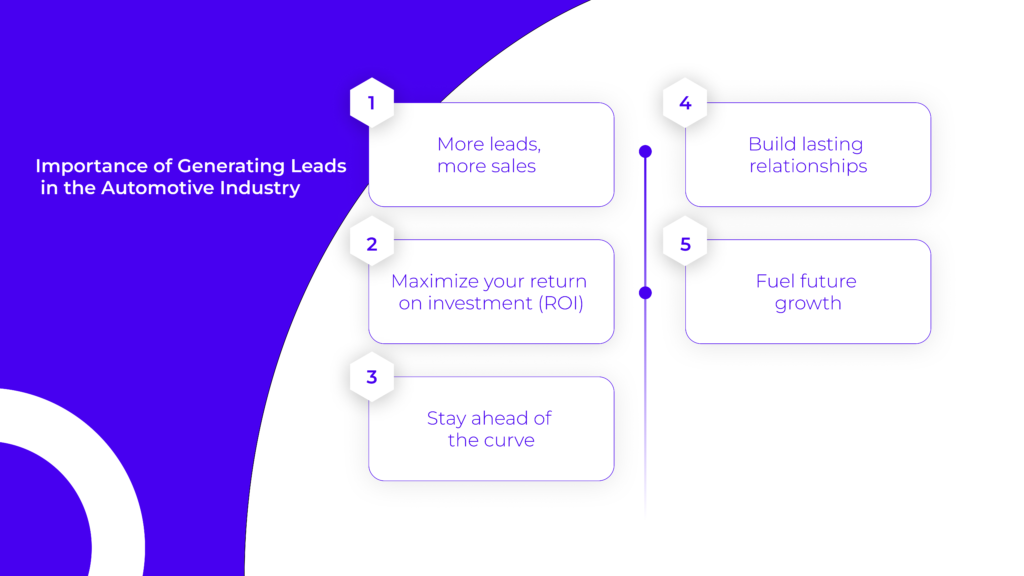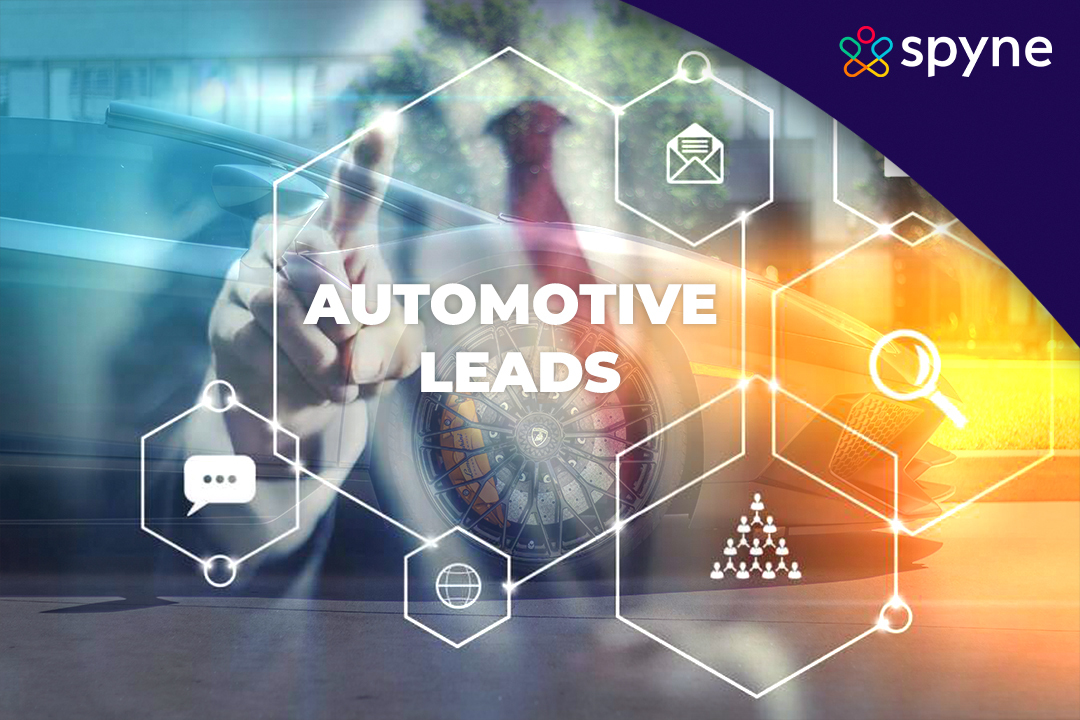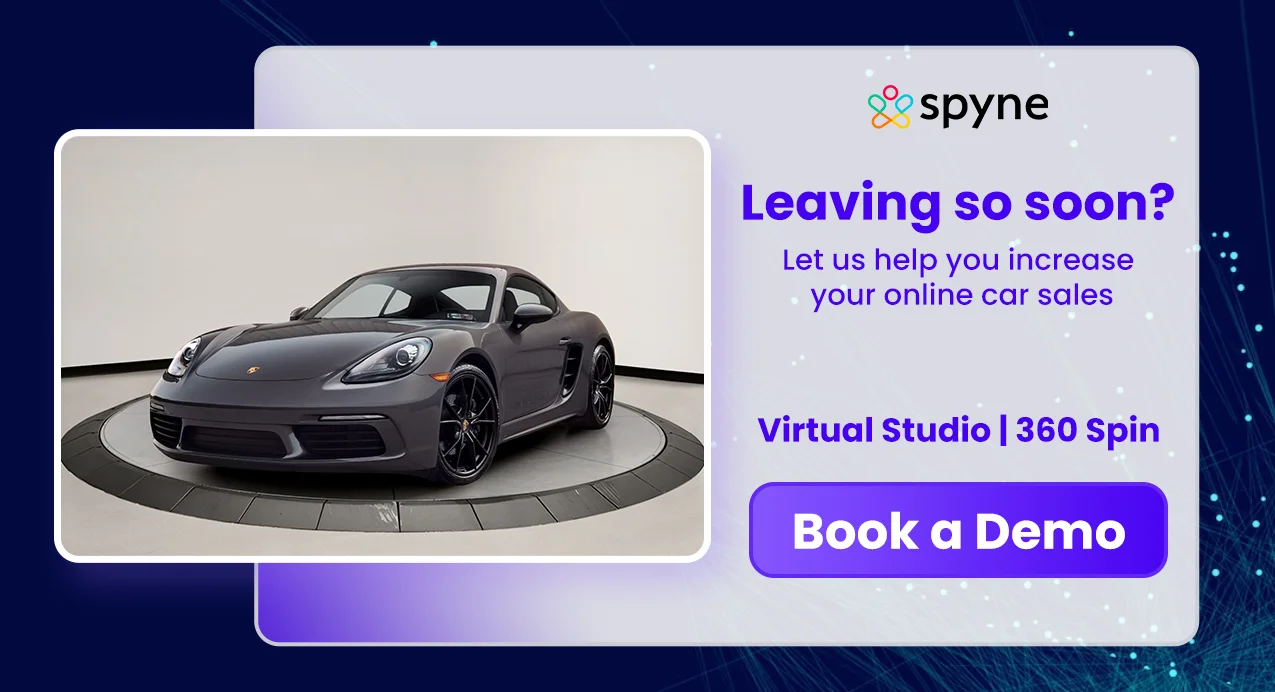Getting people interested in buying cars is super important. Did you know that most people (about 88%) check online before they buy a car? Quality automotive trigger leads are the source of the success of your car sales. This means car dealerships need to be smart about getting people’s attention. With so many dealerships, they must find new ways to stand out. Using fancy technology and making cool ads are some ways they can do that. Let’s look at these ideas and see how car dealerships can use them to generate quality automotive leads and do well in the evolving automotive industry market.
What is an Automotive Lead?
An automotive lead is a potential customer interested in buying a car or related services. Customers apply for an auto loan and schedule an oil change of which dealership has the information is considered the dealer’s lead. The dealer gets over half their CRM (customer relationship management) traffic through a lead form submission. This interest can manifest in various ways, not just by physically visiting a dealership within the last 24 hours in search of a vehicle and financing for that vehicle.
The “within the last 24 hours” timeframe is too narrow. Leads can be valuable even if they expressed interest weeks or months ago. The key element is their demonstrated interest in buying a car, regardless of the timeframe.
How Do Car Sales Leads Work?
Car sales lead work by identifying and reaching out to potential customers interested in purchasing a car. These leads are generated through various channels, such as automotive social media marketing, online advertising, and referrals from existing customers. This process involves multiple strategies, including leveraging personal relationships and utilizing internal and external marketing. Here’s how it typically works.
1) Lead Generation: Leads can be generated through various channels, such as personal referrals, marketing campaigns, and external advertising.
2) Qualification: Once leads are generated automatically, they must be qualified to ensure they are potential customers. This can involve assessing their budget, preferences, and readiness to buy.

3) Contact and Engagement: Initiating contact through phone calls, emails, or text messages to build rapport, understand needs, and provide information about cars and financing options.
4) Test Drives and Demonstrations: Test drives or virtual demonstrations can be offered to help leads experience the vehicle.
5) Closing the Sale: Guiding the lead through negotiations, financing discussions, and paperwork.
6) Post-Sale Follow-Up: Maintaining communication through follow-up calls, emails, or service appointment invitations to nurture the relationship.
What is Automotive Lead Management?
Automotive lead management involves nurturing and tracking leads for car dealerships. Individual salespeople track their leads based on their interactions online or in person. Auto lead management software tools are standard these days. The leads are segregated and assigned to different salespeople to distribute an equal number of potential customers. We have mentioned some top strategies for auto lead management a dealership can integrate into its business.
Tips to Improve Auto Lead Management to Increase Sales
1) Collect information upon first contact: Collect the customer’s information when they enter the dealership. Therefore, it will allow you to provide the suitable vehicle the buyer wants.
2) Integrate a referral system: Salespeople can offer bonuses to satisfied customers who bring new clients to the dealership. Therefore, it will allow your dealerships to generate quality car dealer leads.
3) Follow-up: The car buying journey is a long process for buyers. It is necessary to stay connected with the individuals who showed interest in a purchase. Salespeople can follow up to convert dead deals into paying customers.
4) Use automotive lead management software: Dealerships can use CRM-focused tools provided by automotive service providers like Spyne. It will allow you to collect broader and more qualified leads to increase your sales.
Types of Automotive Leads
Auto lead cars can generally be categorized into two main types: new and used car leads. Here’s a brief overview of each:
1) New Car Leads
- Individuals seeking to purchase new cars.
- Usually produced by marketing initiatives, inquiries, and recommendations.
- The sales process aims to highlight the newest models, features, and incentives.
2) Used Car Leads
- Individuals seeking to buy previously owned cars.
- Produced by internet listings, marketing campaigns, and trade-ins.
- Value proposition, history, and warranty alternatives are highlighted in the sales process.
Different strategies are needed for these two categories of leads, depending on their unique requirements and preferences.
How To Convert Leads into Customers for Automotive Business?
You must consider a few strategies to get more customers for your automotive business. Here is a brief of the steps:
1) Turn declines into sales: Address concerns, offer alternatives, and follow up with personalized offers.
2) Delight with small gifts: Provide valuable resources, branded items, or surprises.
3) Stay connected: Send personalized greetings, gifts, and exclusive offers at critical times.
4) Reward loyalty: Create a tiered or points-based program with increasing benefits.
5) Encourage referrals: Offer incentives for referring new customers and showcase their success.
6) Online Engagement: Create valuable content, run interactive features, and respond to feedback.
7) Connect with your community: Sponsor events, partner with businesses, and offer educational workshops.
8) Personalized experience: Understand and fulfill your customers’ needs and provide tailored recommendations per their requests.
Importance of Generating Leads in the Automotive Industry
Automotive lead generation for car dealerships provides the sales team with a constant flow of qualified leads. Therefore, leads are already interested in the particular automotive business’s services and products, so converting them into paying customers is easy. In the competitive world of automotive sales, generating leads isn’t just a bonus. It’s the engine that drives your success. Here’s why.
More Leads, More Sales
It’s simple math. A steady stream of potential customers interested in your cars translates directly to increased sales volume. The more qualified leads you have, the more opportunities you have to convert them into paying customers.

Maximize Your ROI
Every marketing dollar you spend should drive results. Effective automotive lead generation for car dealership strategies ensures you’re attracting the right audience, maximizing the impact of your marketing efforts, and driving a better return on your investment.
Stay Ahead of the Curve
The automotive industry is constantly evolving, and so should your car sales lead generation tactics. By adapting to changing consumer behavior and utilizing innovative methods, you can gain a competitive edge over dealerships stuck in traditional approaches.
Build Lasting Relationships
Automotive lead generation for car dealership isn’t just about the initial sale. It’s about nurturing potential customers through the buying journey and turning them into loyal advocates. You can build relationships that turn one-time buyers into repeat customers by providing valuable information, personalized offers, and exceptional service.
Fuel Future Growth
A robust pipeline of qualified leads ensures the sustainability and future development of your auto leads for car salesman. You’re laying the groundwork for long-term success in the ever-changing automotive landscape by consistently generating new leads.
Benefits of Best Auto Leads
There are various benefits of car sales leads. Increased receptiveness to sales messages is a crucial benefit of the best automotive lead providers, but there are many others! Here’s a more comprehensive breakdown:
1) Increased Receptiveness: They’ve already shown interest in buying a car, making them warmer prospects likely to engage with your messages.
2) Higher automotive lead Conversion Rates: They’re closer to the buying stage, leading to a higher chance of converting them into customers than general audiences.
3) Targeted Marketing: You can tailor your communication to their needs, wants, and vehicle preferences, making your messages more relevant and impactful.
4) Increased Efficiency: Focus your sales efforts on qualified auto lead cars instead of spending time and resources on cold calls or generic marketing.
5) Valuable Data Insights: Analyze lead data to understand your target audience better, refine your marketing strategies, and identify untapped opportunities.
6) Faster Sales Cycle: Shortens the time it takes to convert leads into customers, accelerating your sales cycle and boosting revenue.
7) Improved ROI: Focusing on qualified leads yields a better return on your marketing and sales investments than generic outreach.
8) Competitive Advantage: A consistent flow of qualified leads gives you a significant edge over dealerships that struggle with car sales lead generation.
Features of Auto Sales Leads
Auto sales leads are potential customers interested in purchasing a vehicle. Here are some key features of auto sales leads:
1) Interest in Purchasing: Auto sales leads have demonstrated an interest in buying a vehicle, typically through online inquiries, showroom visits, or test drives.
2) Contact Information: These leads provide their contact details, such as name, phone number, and email address, facilitating direct communication for sales follow-up.
3) Qualification: Leads may be qualified based on budget, creditworthiness, and specific vehicle preferences, helping sales teams prioritize efforts toward high-potential leads auto.
4) Source Tracking: Understanding the automotive lead source—whether from online forms, social media, referrals, or walk-ins—helps tailor sales strategies and allocate resources effectively.
5) Communication History: Recording all interactions and follow-up communications with leads enables sales representatives to maintain a comprehensive view of the relationship and track progress toward conversion.
Top 25 Ideas for Automotive Lead Generation for Car Dealership
Generating high-quality auto dealer leads for success is crucial. But with many strategies, figuring out where to start can take time. Here are the best 25 ideas for leads for auto dealers.
1) Meaningful Content
Create high-quality, informative content that is relevant to your target audience. This could include blog posts, articles, videos, infographics, etc.
2) Hire an experienced copywriter
A good copywriter can help you create persuasive and effective content-generating leads. They can also help you with keyword research and search engine optimization (SEO).
3) Mobile-optimized website
Make sure your website is mobile-friendly. As more people are using their smartphones and tablets to research cars, your website should be easy to navigate and load quickly.
4) Cross-promotion with different businesses
Cross-promotion is a powerful marketing strategy where two or more businesses collaborate to promote each other’s products or services to their respective audiences.
5) Re-establish connections with lost clients
Reach out to past customers who haven’t purchased a car from you. Offer them a special deal or incentive to come back to your dealership
6) SEO-optimized blog post
Write blog posts that are optimized for search engines. This means using relevant keywords and phrases throughout your content. Doing this can improve your chances of appearing in search results when people are looking for car information. Dealerships must prefer for automotive seo services.
7) Create a Production Video Walkthrough
Create high-quality production videos that showcase your dealership and the cars you sell. This is a great way to give potential customers a virtual tour of your dealership and make them feel more comfortable doing business with you.
8) Try as many reach out as possible through the sales team
Every day, try to reach out to as many people as possible through the sales representative team. So that you can generate more leads each day.
9) Run a PPC campaign
Running a successful PPC campaign requires careful planning, execution, and ongoing optimization. Choose the right platform, craft compelling ad copy, select relevant keywords, set the right bids and budget, and optimize your campaigns.
10) Create a referral program
Offer incentives to customers who refer their friends and family to your dealership. This is a great way to generate new leads and build brand loyalty.
11) Stay organized with a dealership-focused CRM
Use a customer relationship management (CRM) system to track your leads and sales activity. This will help you stay organized and ensure you follow up with all potential customers.
12) Choose the best third party for inventory
Partner with a reputable third-party inventory provider to access a broader selection of cars. This will help you attract more customers and make more sales.
13) Use direct email marketing
Segment your audience for targeted messaging, personalize emails with names and relevant offers, ensure clear unsubscribe options, and comply with spam laws.
14) Make it easy for customers to share your message on social media
Include social sharing buttons on your website and marketing materials, create shareable content like infographics or videos, and run social media contests.
15) Use High-Quality Images
High-quality images are crucial for grabbing attention, enhancing engagement, and improving brand perception. Visual car merchandising is vital for businesses to stand out.
16) Work actively on Facebook marketing
Facebook is a great platform to connect with potential customers and build relationships. Create a Facebook page for your car dealership leads and share exciting and engaging content, such as news articles, blog posts, and videos.
17) Show up in local Google searches with Google Places
Claim and optimize your Google My Business listing. This will help you show up in local Google searches when people are looking for car dealerships in your area.
18) Get Referrals from LinkedIn
Use LinkedIn to connect with other professionals in the automotive industry. Ask them to refer their clients to your automotive dealer leads.
19) Make it easy to collect leads on every page of a dealership’s website
Add social media sharing buttons to your website and blog posts. Make it easy for customers to share your content with friends and followers.
20) Partner with influencers
Partner with social media influencers in the automotive industry. They can help you reach a wider audience and promote your dealership to their followers.
21) Get customer reviews
Encourage customers to leave reviews on your website and Google My Business listing. Positive reviews can help you build trust and credibility with potential customers
22) Website plugins
Use website plugins to capture leads and track visitor behavior. This will help you learn more about your potential customers and improve your marketing efforts.
23) eBooks
Create eBooks that offer valuable information to potential customers. This is a great way to capture leads and build relationships.
24) Advertise on car stickers
Advertise your dealership on car stickers. This is a great way to reach a targeted audience of potential customers.
25) Monitor real-time analysis
Track and monitor the real-time analysis of lead generation for car dealers continuous improvement.
Strategies for Generating Automotive Leads
Automotive lead generation for car dealership requires a multifaceted approach, leveraging various strategies to reach potential customers effectively. Here’s a breakdown of the strategies you’ve listed and how they can be implemented:
1) Social Media
Utilize platforms like Facebook, Instagram, Twitter, and LinkedIn to engage with your audience, share relevant content, and showcase your vehicles and dealership.
2) Create Content
Develop high-quality content such as blog posts, videos, infographics, and car reviews to educate and attract potential leads.
3) Invest in SEO
Optimize your website and content for search engines to improve visibility and attract organic traffic.
4) Referrals and Affiliates
Encourage satisfied customers to refer their friends and family to your dealership. You can also collaborate with affiliates or influencers in the automotive niche.
5) Blogging
Maintain a blog on your website to provide valuable information about cars, maintenance tips, industry news, etc., which can attract organic traffic and leads.
6) Boost Website Conversion Rate
Optimize your website for conversions by improving user experience, simplifying the buying process, and implementing clear calls to action.
7) Email Marketing
Build an email list and send targeted campaigns with promotions, newsletters, and updates to nurture leads and encourage them to purchase.
8) Partner with Local Businesses
Forge partnerships with complementary businesses in your area, such as auto repair shops or insurance companies, to expand your reach and tap into your customer base.
9) Search Engine Ads
Run pay-per-click (PPC) ads on search engines like Google to target users actively searching for automotive-related keywords.
10) Attract Leads on Social Media
Run targeted social media ads to reach specific demographics interested in cars or those in the market for a vehicle.
11) Increase Online Presence
Ensure your dealership is listed on online directories, auto leads review platforms, and Google My Business to improve visibility and credibility.
12) Implement Content Marketing
Develop a content marketing strategy that aligns with your target audience’s interests and pain points to attract and engage potential leads.
13) Creating a Target Audience
Define your ideal customer persona to tailor your marketing efforts and messaging effectively.
14) Publish Video Walkthroughs
Showcase your inventory through video walkthroughs, test drives, and tutorials to give potential buyers an immersive experience.
15) Use Email Automation
Set up automated email sequences to deliver personalized content and follow-ups based on user actions and interests.
Remember, consistent car catalog, tracking, and refining your strategies based on data and feedback are crucial to generating automobile leads.
Tools for Automotive Lead Generation for Car Dealership
Automotive leads are crucial; you will require a few tools for high-quality automotive lead generation for car dealership. Various tools are used for car dealership lead generation.
Here is a list of a few tools:
AeroLeads
This platform helps you find email addresses and contact information for potential customers in the automotive industry. It integrates with various CRM and marketing automation platforms, making adding leads to your sales pipeline easy.
CallPage
This tool lets you add click-to-call widgets to your website and track call performance. It can help capture leads who prefer to speak with a salesperson directly.
HubSpot
HubSpot offers comprehensive marketing, sales, and service tools, including lead capture forms, email marketing, and analytics. It’s a good option for businesses looking for an all-in-one solution.
OptinMonster
This tool helps you create high-converting popups, opt-in forms, and slide-ins to capture leads on your website. It offers various targeting options to ensure your messages reach the right audience.
LeadFuze
This platform helps you find B2B leads based on specific criteria, such as industry, job title, and company size. It can be helpful for targeted outreach campaigns.
Agile CRM
This CRM for automotive industry is designed for sales teams of all sizes and offers features like lead, contact, and pipeline management. It’s a good option for businesses looking for a user-friendly and affordable CRM.
Sumo: This suite of tools helps you grow your email list and website traffic with tools like popups, welcome mats, and list builders. It’s a good option for businesses looking for a simple, effective way to capture leads.
Unbounce: This platform allows you to create high-converting landing pages to capture leads from your marketing campaigns. It offers a variety of templates and drag-and-drop functionality, making it easy to create professional-looking landing pages without coding.
Challenges and Solutions in Car Dealership Lead Generation
Understanding the challenges and automotive solutions in automotive lead generation for car dealership is crucial for developing an effective strategy. Here are some key points to consider:
Challenges
1) Identifying high-quality leads: Differentiating serious buyers from casual browsers or tire kickers can be difficult.
2) Competition: The automotive industry is saturated, making it challenging to stand out and capture attention.
3) Data accuracy and compliance: Ensuring leads are accurate and follow privacy regulations is crucial.
4) Personalization and engagement: Targeted offers, and messages require personalized communication.
Solutions
1) Leverage data analytics: Use website tracking, CRM data, and social media insights to identify qualified leads.
2) Targeted marketing campaigns: Use paid, SEO, and content marketing to reach specific demographics and interests.
3) Data validation and cleansing: Employ tools and processes to verify lead information and ensure compliance.
4) Dynamic content and personalization: Use customer data to tailor website content, email marketing, and offers.
Use Cases of Automotive Lead Generation for Car Dealership
Leads are pivotal in connecting businesses with potential customers, facilitating transactions, and nurturing relationships. There are various applications of leads in the automotive industry. Let’s explore a few use cases of automotive sales leads:
1) New car sales: Generate leads for potential buyers interested in purchasing new vehicles.
2) Used car sales: Target individuals looking to sell or trade in their cars.
3) Service and maintenance: Attract customers needing repairs, oil changes, or other services.
4) Parts and accessories sales: Capture leads interested in specific car parts or accessories.
5) Subscription and car-sharing services: Target potential customers for recurring car usage programs.
6) Marketing research and surveys: Gather feedback and insights from potential and existing customers.
6 Future Trends in Automotive Lead Generation for Car Dealership
As the automotive industry continues to evolve, so do the strategies and technologies utilized in automotive lead generation for car dealership. Let’s examine the future trends in automotive sales leads.
1) Artificial intelligence (AI) and machine learning (ML): AI can predict buying behavior and personalize marketing efforts.
2) Personalized video marketing: Engaging content tailored to individual needs and preferences.
3) Omnichannel engagement: Seamless experience across offline, mobile touchpoints, and automotive internet leads.
4) Voice search optimization: Optimize content and websites for voice search queries.
5) Focus on customer experience: Building trust and relationships through personalized interactions.
6) Growing popularity of electric vehicles (EVs): Targeting specific marketing campaigns for EV leads.
Conclusion
In the automotive sales industry, the ability to generate quality automotive leads and win them over is essential for success. Car dealerships can survive and thrive in today’s competitive market by embracing innovative strategies and prioritizing customer satisfaction. As the automotive industry continues to evolve, there will always be new avenues for dealerships to explore and conquer. With perseverance and strategic adaptation, car dealerships can continue to excel and remain leaders in the ever-changing world of automotive sales.




























